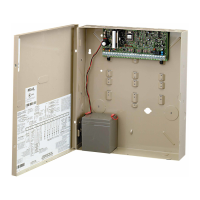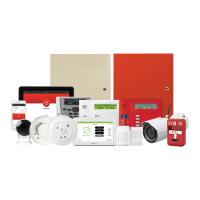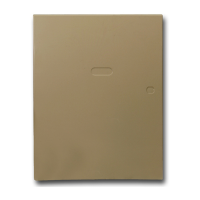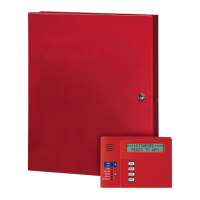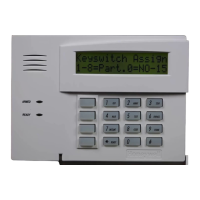VISTA-15P/20P/SIA Installation and Setup Guide
25
Troubleshooting (Continued)
Problem:
4-wire smokes will not reset
1. Make sure the 4-wire smokes are NOT on Zone 1. The power on zone 1 will reset for
2-wire smokes only. Any programmed relay or trigger will NOT activate for Fire Reset
if the fire alarm is on zone 1. It must be on ANY other zone.
2. The short on the zone is not sustained at the time of the second disarm. This will
happen if the zone is shorted manually with a screwdriver, pliers, etc. and the short is
released before disarming. For best results, use the test button on the smoke
detector.
3. Check Relay or Trigger programming and wiring.
Problem:
Zone Doubled zones are in
“Check”
1. There is a short on one of the zone circuits. If one is shorted, then both are shorted.
Check wiring.
2. Use only Normally Closed contacts for doubled zones. If a Normally Open device is
used, it will short both zones when activated.
Problem:
The on-board panel zone(s) are
staying faulted
1. Check the values of the resistors used. The zones require a 2K resistor (if enabled
per the next step). The 2K resistor colors are red, black, red, gold.
2. Check each zone program option of “Hardwire Type” to make sure it matches the
zone wiring (does not apply to zone 1. Zone 1 must use a resistor). If a 2K resistor is
used, this option needs to be set to option “0” for EOL. If a resistor is used and
options 1 or 2 (N.C. and N.O.) is selected, that zone will stay faulted. N.C. means
that a shorted condition is normal. N.O. means that an open condition is normal.
3. Make sure the zone circuits connected to the panel are NOT offset by one or more
terminals.
Problem and Message:
Check 100 for wireless receiver
1. A jam condition can cause this if “RF Jam” option is not enabled in *22. If *22 is
disabled, enable it to see if the “Check 100” comes back or if an “RF Jam” occurs. If
“Check 100” comes back, then it is not a jam condition.
2. Make sure there is only one receiver connected to the panel. If there are two
connected, you may or may not get a “Check 100”. Disconnect the receiver and wait
45 seconds for the panel to scan the ECP bus and see if it will clear with two disarm
commands. If it does not clear, we can assume there is an address and/or wiring
issue preventing ECP communication. If it does clear, then there is another receiver
on the system or a different device at address 00. Test a transmitter to see if it
works.
3. If the receiver has lost ECP communication to the panel, verify the dip switches are
correct (must be set to address 00, all addressing dip switches need to be OFF) and
check wiring. A different harness can be tried to make sure there is not a loose
connection within the harness connector. If a separate power supply is used, connect
a common ground wire between the power supply negative and panel aux power
negative, terminal 4.
4. If there is not a receiver on the system, delete any zone that has a serial number in it
and/or enter all 0’s in *24 House ID location in programming.
Problem and Message:
Check 107 – 111 for 4219/4229
1. This is showing that a problem exists on a respective address, E.g. “Check 107”
means there is a problem with the 4219/4229 at address 7. There are 2 conditions to
troubleshoot.
2. If the Check 1XX exists (XX = 4219/4229 address), but the zones are working, then,
the cover tamper is not engaged. Simply engage the cover tamper, restore the zones
and type in 2 disarm commands to clear the trouble. Since the zones are working,
the wiring and addressing are correct. If the zones are not restored, the Check
condition may not clear.
3. If the Check 1XX exists and the zones are also in Check, then, the expander has lost
ECP communication to the panel. Verify the dip switches are correct for that address
and check wiring (try using the terminals instead of wire harness). If a separate
power supply is used, connect a common ground wire between the power supply
negative and panel aux power negative, terminal 4.
4. If the Check 1XX exists and there are no expanders on the system and no zones are
enabled, check all 16 outputs in *79 and delete any that are enabled for the address
that is in trouble. If there are zones in Check respective to that address, delete the
zones.

